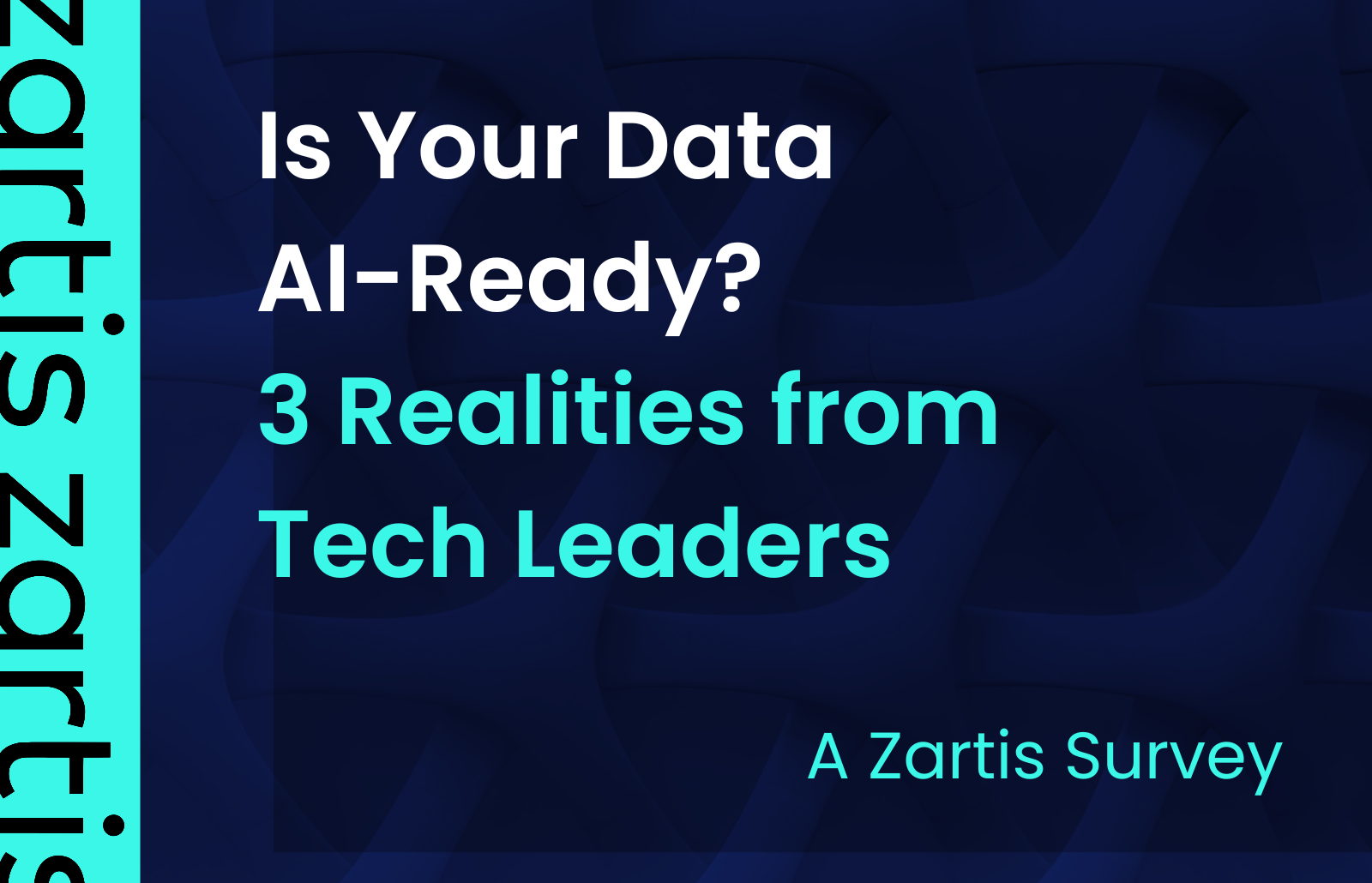The adoption of artificial intelligence is accelerating across every industry, creating a clear sense of urgency for business leaders to integrate AI into their products and operations. However, Zartis new State of AI Adoption 2025 Survey reveals a significant gap between this ambition and the foundational data readiness required for success. While a large majority of companies are actively exploring or integrating AI, their ability to execute is directly tied to the quality of their underlying data.
The survey isolates the single greatest determinant of AI success: data readiness. When tech leaders assessed their own organizations, their responses created a clear hierarchy of strategic potential:
- 29% Very well prepared: “Our data is clean, well-structured, and readily usable for AI applications.”
- 55% Somewhat prepared: “Our data is usable with some preprocessing and cleanup required.”
- 14% Not well prepared: “Our data has significant issues like duplicates, gaps, or inconsistent formats.”
Understanding what each level of data readiness truly means requires a clear framework for data quality assessment. As outlined in our deep dive on the importance of data in an AI-driven world, data quality is measured across six critical dimensions: accuracy, completeness, consistency, timeliness, validity, and uniqueness. These dimensions form the foundation for determining whether data can reliably fuel AI systems—and where each organization sits on the readiness spectrum.
This article will analyze what each of these three realities means for a company’s strategic planning, the practical implications for their teams, and the necessary steps to achieve meaningful success with AI. We begin with the minority of organizations that have already laid the groundwork for innovation.
1. The Vanguard: 29% “Very Well Prepared”
This cohort of organizations represents the vanguard in the race for AI adoption. Having already made the crucial investments in data hygiene and governance, they hold a significant strategic advantage. For these leaders, the conversation is no longer about the technical feasibility of AI but about its strategic application. The primary challenge has shifted from data preparation to high-impact deployment. However, this advantage is perishable. Their challenge is to maintain data discipline while accelerating deployment, ensuring that speed does not lead to a degradation of the very foundation that enables their success.
This group’s core attribute is its strong data foundation, with leaders describing their data as “clean, well-structured, and readily usable for AI applications.”
For these companies, the primary focus shifts from foundational cleanup to strategic execution. With reliable data at their fingertips, they are positioned to leverage AI to accelerate top business priorities, such as “Shipping new features” and “Improving customer experience.” Unlike their peers, this group can confidently tie AI initiatives to these goals because their data foundation provides reliable fuel for innovation, not a source of constant friction.
For the “Very Well Prepared,” the challenge is aligning powerful AI capabilities with tangible, high-impact business goals to generate measurable ROI.
While this group is in an enviable position, they represent just over a quarter of businesses. The reality for the majority of organizations is far more complex and fraught with hidden challenges.
2. The Majority: 55% “Somewhat Prepared”
This category represents the most common reality for businesses today. Situated in a precarious middle ground, these organizations possess data that is fundamentally usable but requires work before it can power reliable AI systems. This position presents both the greatest opportunity for progress and the most significant hidden risk in the journey to AI adoption.
These organizations find themselves in a situation where “Our data is usable with some preprocessing and cleanup required.”
The critical challenge for this group lies in the ambiguity of “some preprocessing.” This seemingly minor caveat often conceals significant operational hurdles and hidden “data debt.” Understanding what this preprocessing actually entails is essential. Our detailed guide on data quality breaks down the core tasks: removing duplicate records, identifying and correcting errors, detecting and handling outliers, and addressing missing values through imputation or deletion. Each of these tasks requires both technical capability and clear governance. This directly threatens the top-line priorities of shipping new features and improving customer experience. An AI model built on inconsistent data will not enhance the customer experience; it will degrade it with unreliable outputs, eroding trust and wasting investment.
For the “Somewhat Prepared,” the immediate priority is to quantify and execute the necessary data cleanup to avoid a critical strategy-execution gap.
For this majority, moving forward requires a pragmatic and honest assessment of their data debt before they can truly capitalize on AI. Their next steps are foundational, much like the final group we will examine.
3. The Foundation Builders: 14% “Not Well Prepared”
The 14% of leaders who identify as “not well prepared” face the most significant data hurdles. However, their situation should not be viewed as a failure, but rather as a moment of crucial clarity. This clarity is an asset. It allows them to architect a data strategy correctly from the outset, leapfrogging the technical debt accumulated by the “Somewhat Prepared” majority.
This group’s challenge is clear and unambiguous; they report that “Our data has significant issues like duplicates, gaps, or inconsistent formats.”
For these organizations, any significant investment in advanced AI tools is premature. For this group, attempting to pursue goals like “Shipping new features” with AI is a non-starter. Their focus must be internal; any external-facing AI initiative is guaranteed to fail, damaging both budget and credibility. Their entire focus must be on addressing the “fundamental data quality challenges” identified in the survey. A strong foundation is not an optional step but an absolute prerequisite for generating any meaningful value from AI.
However, organizations in this position have strategic options beyond traditional data collection and cleanup. When real-world data has significant quality issues or is limited by privacy regulations, synthetic data generation offers a practical alternative. By artificially generating data that mirrors the statistical properties of real datasets, organizations can accelerate development cycles, test AI systems safely, and comply with stringent privacy regulations like GDPR and HIPAA—all while building toward a more robust real data infrastructure. This approach is particularly valuable in regulated industries where access to production data is constrained.
For the “Not Well Prepared,” the most strategic investment is not in AI applications, but in a dedicated data quality and governance program.
Call to Action: Strengthen Your Data Foundation for AI Success
Whether a company is leading the pack, navigating the messy middle, or starting from scratch, the path to unlocking AI’s true potential begins with a deliberate and strategic focus on data. The technology may be complex, but the starting point is clear: you can only build as high as your foundation allows.
The survey’s analysis culminates in a primary strategic recommendation for every organization, regardless of its current state of readiness: “Strengthen Data Foundations for AI Success.” This involves moving beyond ambition and implementing concrete, disciplined practices.
The survey’s strategic recommendations provide a clear, disciplined framework for action. Every leader must prioritize the following initiatives to build a competitive data foundation:
- Conduct Data Maturity Assessments. Evaluate the current state of your data governance, cleaning processes, and architecture. A frank assessment is the first step to identifying critical gaps and creating a realistic roadmap for improvement.
- Prioritize Infrastructure Upgrades. Invest in the necessary tools and platforms to ensure your data is clean, accessible, and scalable for AI workloads. This is a foundational investment in future innovation and operational efficiency.
- Implement Ongoing Data Quality Management. Data hygiene is not a one-time project. Establish clear processes, roles, and ownership to maintain data quality as your business evolves. This includes implementing the six dimensions of data quality -accuracy, completeness, consistency, timeliness, validity, and uniqueness – as ongoing operational standards. For organizations facing data scarcity or privacy constraints, consider synthetic data generation techniques as a complementary strategy to augment real-world datasets while maintaining compliance and accelerating AI development.
Conclusion
Ultimately, whether you are a vanguard aligning AI to ROI, part of the majority untangling hidden data debt, or a foundation-builder starting fresh, the mandate is the same: treat your data as the strategic asset it is. The organizations that build their initiatives on a foundation of high-quality, well-governed data will be the ones to achieve a sustainable, long-term competitive advantage in an increasingly intelligent world.
Download the State of AI Adoption 2025 Survey Report for more detailed information and insights!
From Assessment to Execution: Partner with Experts Who Understand the Journey
The gap between AI ambition and execution often comes down to a single question: “What do we actually need to do next?”
At Zartis, we’ve guided organizations through every stage of data readiness—from conducting comprehensive maturity assessments to implementing governance frameworks and deploying production-ready AI systems. Whether your challenge is quantifying hidden data debt, choosing between synthetic and real data strategies, or aligning AI initiatives with business KPIs, we bring the technical depth and strategic clarity to move you forward.
Our approach is pragmatic: we assess where you are, identify the highest-impact next steps, and work alongside your teams to execute with confidence.
Ready to turn data readiness into competitive advantage? Connect with our AI consulting team to discuss your specific challenges and explore how we can help.

